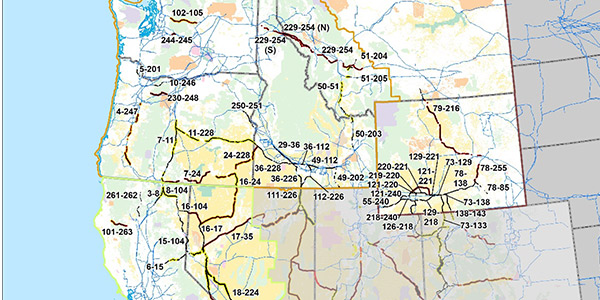Federal officials are seeking input on a revised plan to use Western federal lands to create a network of energy infrastructure pathways that would likely provide a big boost to renewable project development.
The West-wide Energy Corridor — really a series of corridors — would wind through seven states, including California, Idaho, Montana, Nevada, Oregon, Washington and Wyoming.
The U.S. Bureau of Land Management, Forest Service and Department of Energy introduced the proposal in September 2005 under the authority of Section 368 of the Energy Policy Act of 2005.
Section 368 directs federal agencies to designate lands in the 11 Western states as right-of-way corridors for electricity transmission and distribution facilities, as well as oil, gas and hydrogen pipelines. It also requires the agencies designating corridors to take into account the “need for upgraded and new electricity transmission and distribution facilities” to “improve reliability,” “relieve congestion” and “enhance the capability of the national grid to deliver electricity.”
In 2009, the agencies prepared a programmatic environmental impact statement (PEIS), and BLM and USFS signed records of decision (RODs) designating about 5,000 miles of Section 368 energy corridors on BLM-administered lands and approximately 1,000 miles on USFS-administered lands.
But the effort to move ahead was stymied in July of that year when several conservation groups — including the Sierra Club and Natural Resources Defense Council — filed suit in federal court alleging that the PEIS and RODs violated the EPAct, National Environmental Policy Act, Endangered Species Act, Federal Land Policy and Management Act and Administrative Procedure Act.
In July 2012, the federal agencies signed a settlement with the plaintiffs that required the agencies to conduct regional reviews of Section 368 corridors and outline a handful of siting principles to guide those reviews.
Those principles require that the corridors must be “thoughtfully sited to provide maximum utility and minimum impact on the environment” and encourage “efficient use of the landscape for necessary development.” The agencies must also define “appropriate and acceptable uses” for specific corridors.
The revised plan contains numerous proposals to shift corridors to alleviate impacts on the environment and Native American reservation lands. It also proposes to eliminate a handful of corridors while adding two new ones in Wyoming and one each in Idaho and Oregon.
New Paths for Renewables
Most significant for renewable developers is a settlement stipulation that requires corridors to “provide connectivity to renewable energy generation to the maximum extent possible while also considering other sources of generation, in order to balance the renewable sources and to ensure the safety and reliability of electricity transmission.”
The revised plan, released Monday, points out that most of the 59 corridors identified in the 2009 West-wide plan already contained existing energy transmission infrastructure that was largely constructed to transmit electricity produced by fossil fuel, nuclear and hydroelectric generating facilities. Since then, the report notes, additional energy infrastructure has been built in those corridors, and many now have pending right-of-way applications for utility-scale renewable resources.
“Renewable energy development in Section 368 energy corridors is critical for connecting renewable energy sources to the grid,” the agencies said.
To bring that point home, the agencies cite the growing need for renewable energy in the West, particularly in California, combined with the remote locations of the regions with some of the greatest potential to generate that energy.
The proposal points to the large number of untapped designated solar energy zones (SEZs) on BLM land near Corridor 18-224 in Nevada.
“There is also a strong interest in solar energy development, combined with substantial existing geothermal energy production in this area. However, a lack of transmission lines to transport solar or geothermal energy to load centers presents a barrier for potential developers,” the plan states.
An isolated area of southeastern Oregon near Wagontire Mountain, positioned close to three Section 368 corridors, contains “significant” wind, geothermal and solar energy potential, according to the report.
“However, renewable energy resources require an additional north-south pathway east of Corridor 7-11 into California. A corridor addition in the area could serve to connect renewable energy to demand,” the plan states.
Wyoming currently has nearly 1,500 MW of installed wind capacity, with another 3,000 MW under construction, the reports notes. While the Gateway West project, slated for completion in 2024, will carry some of that generation to the West Coast, “additional infrastructure may be needed to transmit wind energy from Wyoming to out-of-state load centers, and Section 368 energy corridors could be well placed to accommodate that need,” the agencies contend.
The federal agencies are seeking comments on the revised plan by Jan. 31, 2021.




